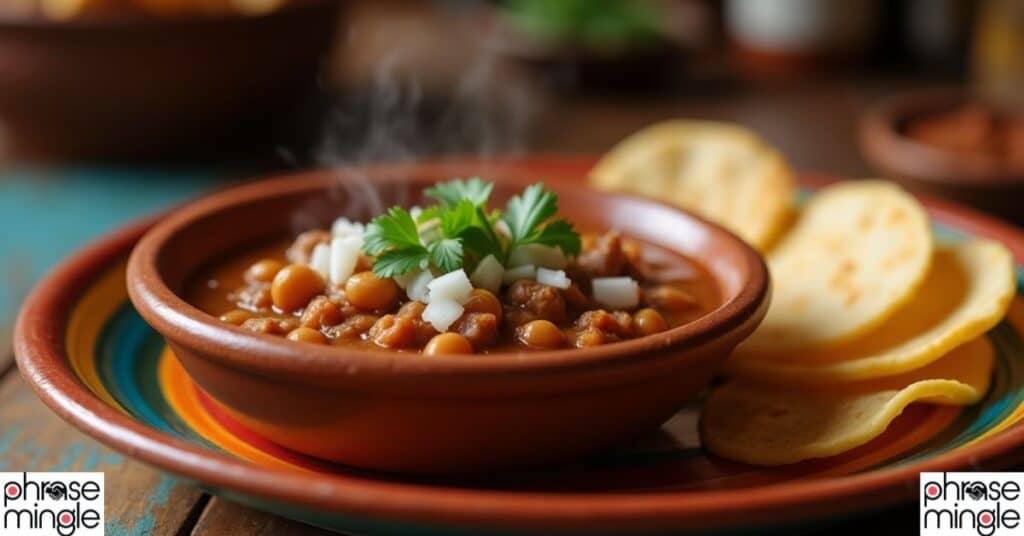Mexican Foods That Start With I, Mexico’s culinary landscape stretches far beyond the familiar tacos and enchiladas most people know. Hidden within the rich tapestry of Mexican cuisine lies an incredible collection of dishes, drinks, and delicacies that begin with the letter “I” each one telling a unique story of regional traditions, indigenous heritage, and culinary innovation.
These lesser known Mexican foods represent centuries of cultural evolution, where pre Hispanic ingredients meet Spanish colonial influences and modern interpretations. From the lima bean stews of the Yucatan to the insect delicacies of Oaxaca, each dish offers a window into Mexico’s diverse culinary soul.
Traditional Main Dishes That Define Regional Identity
When it comes to understanding a region’s culture, traditional main dishes offer a flavorful window into its identity. These meals are more than just food they reflect generations of history, local ingredients, and cherished cooking techniques. From spicy stews to hearty roasts, each dish tells a story unique to its homeland and the people who proudly serve it.
Ibes Con Puerco: Yucatan’s Comfort Food Classic

Ibes Con Puerco stands as one of the Yucatan Peninsula’s most beloved comfort foods. This hearty stew combines lima beans with pork in a rich, flavorful broth that’s been satisfying families for generations.
The dish traces its roots to ancient Mayan cuisine, where lima beans served as a crucial protein source. Spanish colonizers introduced pork, creating this perfect fusion that defines Yucatan cooking today. The preparation involves slow cooking tender pork shoulder with black lima beans, tomatoes, and a distinctive blend of regional spices including achiote and sour orange juice.
What makes this dish special isn’t just its taste – it’s the technique. Traditional cooks in Merida and surrounding areas insist on using clay pots, which impart a subtle earthiness that metal cookware simply can’t match. The beans must be soaked overnight, then cooked until they’re creamy but not mushy.
Key ingredients include:
- Black lima beans (ibes negros)
- Pork shoulder or ribs
- Achiote paste (recado rojo)
- Sour orange juice
- Roma tomatoes
- White onions
- Epazote herb
IF YOU WANT TO READ ABOUT DESSERTS CLICK HERE
Iguana Soup: Oaxaca’s Controversial Delicacy

Iguana Soup represents one of Mexico’s most polarizing yet culturally significant dishes. In Oaxaca and parts of southern Mexico, this protein rich soup carries deep cultural meaning that extends far beyond mere sustenance.
The preparation of iguana soup follows strict seasonal patterns. Local hunters typically catch iguanas during the dry season when the reptiles are more accessible. The meat, which tastes surprisingly similar to chicken with a slightly fishy undertone, gets combined with vegetables, herbs, and spices to create a nutritious broth.
Indigenous communities have consumed iguana for over 1,000 years. The practice continues today not just for tradition’s sake, but because iguana meat provides exceptional protein content nearly 18 grams per 100gram serving, along with essential amino acids that are often scarce in rural diets.
Nutritional benefits of iguana meat:
| Nutrient | Per 100g Serving |
|---|---|
| Protein | 18.1g |
| Fat | 0.9g |
| Calcium | 53mg |
| Iron | 2.1mg |
| Phosphorus | 157mg |
Izote Flower Soup: Central Mexico’s Seasonal Treasure

Izote Flower Soup showcases Mexico’s incredible biodiversity and seasonal cooking traditions. This delicate soup appears on tables across central Mexico during late spring and early summer when izote flowers bloom on yucca plants.
The flowers themselves offer a unique flavor profile slightly sweet with a subtle bitterness that balances beautifully with chili infused broths. Traditional preparation involves carefully cleaning the flowers, removing the bitter stamens, then simmering them with tomatoes, onions, and various regional chilies.
This soup represents more than just seasonal eating it’s a connection to pre Hispanic agricultural practices. Indigenous communities have harvested izote flowers for centuries, understanding their nutritional value and medicinal properties long before modern science confirmed their high vitamin C content.
Street Food Sensations and Appetizers
Street food and appetizers capture the bold, bite sized essence of a region’s culinary flair. These quick, flavorful delights are often the first taste of local culture.
Infladitas: Puebla’s Perfect Puffed Tortillas
Infladitas represent street food artistry at its finest. These small, puffed tortillas from Puebla require incredible skill to create the masa must be rolled to exactly the right thickness, then cooked at precisely the right temperature to achieve that characteristic puff that creates a perfect pocket for fillings.
The technique involves pressing fresh masa into small circles, then placing them on a hot Comal. As the tortilla cooks, steam builds between the layers, creating the signature inflation that gives these treats their name. The timing is crucial too long and they become tough, too short and they won’t puff properly.
Street vendors in Puebla fill these delicate pockets with various combinations of beans, cheese, salsa Verde, and pickled vegetables. The contrast between the crispy exterior and soft, warm interior makes them irresistible to locals and tourists alike.
Itacate: The Original Grab-and-Go Meal
Itacate deserves recognition as Mexico’s original portable meal. Long before modern food packaging, Mexican travelers relied on these carefully wrapped bundles of food for sustenance during long journeys.
The word “itacate” comes from the Nahuatl “itacatl,” meaning provisions for a journey. Traditional itacate includes tortillas, beans, dried meat, cheese, and chili peppers all wrapped in cloth or large leaves to keep everything fresh and protected.
Modern Mexican families still prepare itacate for road trips, work lunches, and picnics. The practice demonstrates the ingenuity of Mexican food culture, where practical needs meet delicious flavors in perfect harmony.
Beverages That Tell Stories
Beverages often hold deep cultural meaning, reflecting local traditions, climates, and customs. From spiced teas to regional brews, every sip shares a story.
Ibarra Hot Chocolate: Mexico’s Liquid Gold

Ibarra Hot Chocolate represents one of Mexico’s most successful culinary exports. The distinctive hexagonal tablets, wrapped in yellow paper with red lettering, have been a household staple since 1925 when the Ibarra family began commercial production in Guadalajara.
What sets Ibarra apart from European hot chocolate is its unique blend of cacao, sugar, cinnamon, and vanilla. The preparation ritual involves dissolving the tablet in hot milk while whisking vigorously with a traditional wooden molinillo, creating a frothy, aromatic beverage that’s simultaneously rich and refreshing.
The chocolate’s grainy texture isn’t a flaw it’s intentional. This characteristic comes from the traditional stone grinding process that creates the perfect balance of smoothness and texture that defines authentic Mexican hot chocolate.
Indio Beer: Working Class Heritage
Indio Beer holds special significance in Mexican working class culture. Launched in 1893, this Vienna style lager became the beer of choice for laborers, farmers, and blue collar workers throughout Mexico.
The beer’s distinctive amber color and slightly sweet flavor profile made it perfect for Mexico’s hot climate. Unlike lighter lagers, Indio’s fuller body provided more satisfaction after long days of physical labor.
Today, Indio remains popular in traditional Mexican establishments, especially those serving authentic regional cuisine. Its robust flavor pairs exceptionally well with spicy foods and rich, heavy dishes.
Iced Horchata: Cool Comfort in Every Sip
Iced Horchata showcases the incredible regional diversity within a single beverage category. While most people know horchata as a rice based drink, Mexican versions vary dramatically by region.
In some areas, horchata is made with almonds, while coastal regions prefer coconut based versions. The preparation involves soaking the base ingredient overnight, then blending with water, cinnamon, vanilla, and sometimes condensed milk.
The key to perfect horchata lies in the straining process. Traditional cooks strain the mixture multiple times through fine cloth to achieve that silky smooth texture that makes iced horchata so refreshing on hot days.
Indigenous Fruits and Natural Ingredients
Indigenous fruits and natural ingredients are the foundation of many regional cuisines, rooted in local landscapes and traditions. These elements bring authenticity, flavor, and a deep connection to the land.
Ilama Fruit: Mexico’s Forgotten Treasure
Ilama Fruit deserves recognition as one of Mexico’s most underappreciated native fruits. This member of the custard apple family grows throughout Mexico’s tropical regions but remains largely unknown outside local communities.
The fruit’s exterior resembles a green hand grenade, but inside lies creamy, sweet flesh with a flavor that combines hints of vanilla, cinnamon, and tropical fruit. Each ilama contains numerous black seeds surrounded by segments of edible pulp.
Traditional uses for ilama extend beyond fresh consumption. Rural communities prepare agua frescas, ice creams, and preserves from the fruit. The leaves also have medicinal applications in traditional healing practices.
Ilama fruit nutritional profile:
- High in vitamin C
- Rich in dietary fiber
- Contains antioxidants
- Good source of potassium
- Low in calories (approximately 60 per 100g)
Icaco En Almíbar: Coastal Preservation Perfection

Icaco En Almíbar represents the ingenuity of coastal Mexican communities in preserving seasonal abundance. This candied preparation transforms the small, round icaco fruit into a sweet delicacy that can be stored for months.
The process involves cooking fresh icaco fruits in sugar syrup flavored with cinnamon, cloves, and sometimes orange peel. The slow cooking process allows the fruit to absorb the syrup while maintaining its shape and developing a jewel like translucent appearance.
Coastal families traditionally prepare large batches during icaco season, storing them in glass jars for special occasions and festivals. The preserved fruit serves as both dessert and gift, often shared with neighbors and visiting family members.
Specialized Regional Delicacies
Specialized regional delicacies showcase the unique creativity and heritage of a specific area. Often rare or seasonal, these dishes offer a true taste of local pride and tradition.
Ixtle Tamales: Oaxaca’s Sustainable Innovation
Ixtle Tamales showcase the incredible resourcefulness of Oaxacan cooking traditions. Instead of corn husks or banana leaves, these tamales are wrapped in fibers from the maguey plant, creating a unique flavor profile and demonstrating sustainable cooking practices.
The ixtle fibers come from the same agave plants used to make mezcal. After the hearts are harvested for alcohol production, the remaining fibers get processed into wrapping material for tamales. This zero waste approach reflects the deep environmental consciousness of indigenous Mexican communities.
The maguey wrapping imparts a subtle, earthy flavor that complements the masa filling. Traditional fillings include beans, cheese, chili peppers, and occasionally small amounts of meat or poultry.
Izote Cactus: Beyond Regular Nopales
Izote Cactus represents a distinct variety of edible cactus that differs significantly from the more common nopal. These paddle shaped segments grow on yucca plants and offer unique nutritional benefits along with distinctive flavors.
The preparation of izote cactus requires careful handling to remove the sharp spines and bitter compounds. Once cleaned, the cactus can be grilled, boiled, or pickled. The flavor is more intense than regular nopales, with a slight lemony tartness.
Nutritionally, izote cactus provides exceptional fiber content, natural mucilage that aids digestion, and compounds that may help regulate blood sugar levels. Traditional healers have used izote preparations for centuries to treat various ailments.
Adventurous Eating: Insects and Unusual Proteins
Adventurous eating explores the bold side of global cuisine, featuring insects and unconventional proteins embraced in many cultures. These surprising foods challenge norms while offering sustainable nutrition.
Insect Tacos: Pre-Hispanic Protein Powerhouses
Insect Tacos challenge modern perceptions while honoring ancient Mexican food traditions. Before Spanish colonization, indigenous communities throughout Mexico consumed various insects as primary protein sources.
Today, insect consumption continues in many regions, particularly Oaxaca, where markets sell grasshoppers (chapulines), ant larvae (escamoles), and various worms (gusanos). These insects provide exceptional nutritional value grasshoppers contain more protein per gram than beef while requiring significantly fewer resources to produce.
Common edible insects in Mexican cuisine:
| Insect | Protein Content | Preparation Method | Regional Specialty |
|---|---|---|---|
| Chapulines | 65-75% protein | Toasted with garlic, lime, salt | Oaxaca |
| Escamoles | 40-50% protein | Sautéed with butter, herbs | Central Mexico |
| Gusanos de Maguey | 55-65% protein | Roasted, ground into powder | Hidalgo |
| Jumiles | 60-70% protein | Eaten live or in salsa | Morelos |
The preparation of insect tacos requires skill and knowledge. Chapulines must be properly cleaned and toasted to achieve the right crunch. Escamoles need delicate handling to preserve their caviar like texture. Each insect requires specific techniques that have been passed down through generations.
Modern Interpretations and Fusion Cuisine
Modern interpretations and fusion cuisine blend traditional flavors with contemporary techniques and global influences. This culinary evolution celebrates creativity while honoring cultural roots.
Flan Imposible: Dessert Engineering Marvel
Flan Imposible represents culinary engineering at its finest. This “impossible” dessert creates distinct layers of cake and flan that seemingly defy physics during preparation but separate beautifully when served.
The magic happens through careful temperature control and ingredient science. The cake batter, being lighter, rises to the top during baking, while the heavier flan mixture settles at the bottom. When inverted for serving, the flan becomes the top layer with the cake underneath.
This dessert gained popularity in the 1970s and has since become a staple at Mexican celebrations. The contrast between the moist cake and silky custard creates a textural experience that satisfies multiple dessert cravings simultaneously.
Regional Food Maps: Where to Find Authentic Flavors
Regional food maps guide curious eaters to the heart of authentic local cuisine. They highlight must visit spots where traditional flavors thrive and cultural stories unfold on every plate.
Yucatan Peninsula: Maya Heritage Lives On
The Yucatan Peninsula offers the richest concentration of “I” foods in Mexico. Ibes Con Puerco remains a Sunday family tradition in Merida, while Iguana Soup appears on menus in smaller towns throughout the region.
Traditional markets in Merida, Campeche, and Valladolid provide the best opportunities to sample authentic preparations. Local families often welcome visitors to share meals, particularly during festivals and celebrations.
Oaxaca: Insect Cuisine Capital
Oaxaca City’s markets offer the most diverse selection of insect tacos and other unusual proteins. The Mercado 20 de Noviembre specifically caters to adventurous eaters, with multiple vendors specializing in traditional insect preparations.
Ixtle Tamales are best found in smaller communities outside the capital, where traditional preparation methods remain unchanged. Many indigenous communities welcome visitors during feast days and religious celebrations.
Central Mexico: Seasonal Specialties
Izote Flower Soup appears seasonally in restaurants throughout central Mexico, particularly in Puebla, Tlaxcala, and Mexico State. The best preparations come from family-run establishments that source flowers directly from local harvesters.
Infladitas remain primarily a Puebla specialty, though similar preparations appear throughout central Mexico under different names.
Cooking at Home: Bringing Mexico to Your Kitchen
Cooking at home brings the vibrant flavors of Mexico straight to your kitchen. With the right ingredients and techniques, you can recreate authentic dishes full of color, spice, and tradition.
Accessibility and Ingredient Sourcing
Many of these Mexican dishes can be adapted for home cooking, though some ingredients require special sourcing. Ibarra Hot Chocolate is widely available in international markets, making it the most accessible option for beginners.
Icaco En Almíbar can be prepared using substitute fruits like small plums or crabapples when fresh icaco isn’t available. The syrup preparation remains the same, creating similar flavors and textures.
Substitution Strategies
For Ibes Con Puerco, lima beans work perfectly as substitutes for the traditional black lima beans. The key lies in the spice blend and cooking technique rather than exact ingredient matches.
Izote flowers can be replaced with squash blossoms or other edible flowers, though the flavor profile will differ. The cooking method and seasoning remain consistent.
Cultural Context: More Than Just Food
Food is deeply woven into the fabric of cultural identity, serving as more than just sustenance. It reflects values, traditions, and the shared experiences that connect communities.
Indigenous Heritage Preservation
These foods represent living connections to pre Hispanic cultures. Insect tacos and Izote Flower Soup maintain traditions that span over 1,000 years, preserving not just recipes but entire cultural practices around seasonal eating and environmental stewardship.
Traditional preparation methods often involve entire communities. Harvesting izote flowers requires knowledge of plant cycles, weather patterns, and sustainable gathering practices that elders pass to younger generations.
Sustainability Lessons
Ixtle Tamales demonstrate zero-waste cooking principles that modern sustainable cuisine movements are only beginning to appreciate. Using agave fibers after mezcal production creates a complete utilization cycle that wastes nothing.
Insect consumption represents perhaps the most sustainable protein source available, requiring minimal water, land, and feed compared to traditional livestock while producing exceptional nutritional value.
Frequently Asked Questions About Mexican Foods that start with i
Curious about Mexican foods that start with I? This FAQ section answers common questions and clears up myths about these unique and flavorful dishes.
Is Mexican cuisine really this diverse?
Mexico’s 32 states each maintain distinct culinary traditions influenced by geography, climate, and cultural history. This diversity creates thousands of regional specialties, many of which remain unknown outside their specific areas.
The Mexican foods beginning with “I” represent just a tiny fraction of this incredible diversity. Each region maintains dozens of unique preparations that reflect local ingredients, seasonal patterns, and cultural preferences.
Where can I try authentic versions of these foods?
Authentic Mexican cuisine requires seeking out family run establishments, traditional markets, and regional specialists rather than generic Mexican restaurants. Many of these dishes appear only in specific regions during particular seasons.
Food tourism in Mexico offers the best opportunities to experience these authentic flavors. Cooking classes with local families provide hands on learning experiences that include cultural context along with culinary techniques.
Are these foods safe for tourists to try?
Most of these traditional Mexican dishes are completely safe when prepared properly. Insect tacos might seem intimidating, but they’re actually safer than many meat preparations due to their traditional cooking methods and natural antimicrobial properties.
The key is choosing reputable sources – established markets, recommended restaurants, and local families who prepare these foods regularly. Avoid street vendors whose preparation methods you can’t observe.
Expanding Your Mexican Food Horizons
These 20 Mexican foods that start with “I” represent just the beginning of an incredible culinary journey. Each dish tells stories of cultural resilience, environmental adaptation, and culinary creativity that span centuries of Mexican history.
From the hearty comfort of Ibes Con Puerco to the adventurous experience of insect tacos, these foods challenge preconceptions while delivering authentic flavors that define regional Mexican identity. The diversity within this single letter of the alphabet demonstrates the incredible richness of Mexican cuisine as a whole.
Whether you’re planning a trip to Mexico or simply want to expand your culinary horizons at home, these foods offer pathways to deeper cultural understanding. Each bite connects you to generations of Mexican cooks who have preserved these traditions through changing times and challenging circumstances.
The next time you encounter Mexican food, remember that behind every familiar dish lies a universe of regional specialties waiting to be discovered. These “I” foods prove that Mexican cuisine extends far beyond what most people know and that’s just the beginning of what this incredible culinary culture has to offer.
Start your exploration with the most accessible options like Ibarra Hot Chocolate or Icaco En Almíbar, then gradually work your way toward more adventurous choices. Each food represents not just a meal, but a cultural experience that connects you to the heart of Mexican culinary heritage.

Jamze Hope,
I am a writer at Phrase Mingle, where i shares insightful phrase guides to help readers enhance their language skills. With a passion for words and clear communication, Jamze creates engaging content that simplifies complex expressions, making them accessible to all.







